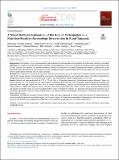A Mixed Methods Exploration of the Role of Participation in a Nutrition-Sensitive Agroecology Intervention in Rural Tanzania

View/
Date
2023-06Author
Santoso, Marianne
Petrie, Halle
Kerr, Rachel
Lane, Charlotte
Kassim, Neema
Martin, Haikael
Mtinda, Elias
Lupafya, Esther
Young, Sera
Metadata
Show full item recordAbstract
Background: Participation is key to the successful implementation of nutrition-related interventions, but it has been relatively overlooked.
Objective: We sought to describe participation intensity among smallholder farmers in a randomized nutrition-sensitive agroecology study
in rural Tanzania. We explored the association between baseline characteristics and overall participation intensity (quantitatively at the
individual level and qualitatively at the group level), the association of participation intensity with 2 process indicators, and the association
between participation intensity and key study outcomes.
Methods: Data came from 7 rounds of surveys with 295 women and 267 men across 29 months and 2 rounds of semi-structured interviews
with the 20 “mentor farmers” who delivered the intervention. Participation intensity was based on the number of months of attendance at
village-level project meetings or household visits (range: 0–29). Multivariable models of participation were built.
Results: Women and men participated for 17.5 7.2 and 13.6 8.3 months, respectively. Participation intensity followed 1 latent tra-
jectory: initially low, with a sharp increase after month 7, and plateaued after the first year. At baseline, higher participation intensity was
associated with older age, higher education, level of women’s empowerment, being in the middle quintile of wealth, and qualitatively,
village residence. Higher participation intensity was associated with 2 process indicators – better recall of topics discussed during meetings
and greater knowledge about key agroecological methods. High participation intensity was positively associated with increased use of
sustainable agricultural practices among all participants, and among women, with husband’s involvement in household tasks and child’s
dietary diversity score.
Conclusions: Participation intensity covaried with key study outcomes, suggesting the value of increased attention to implementation in
nutrition-related programs for providing insights into drivers of impact. We hope that investigations of participation, including participation
intensity, will become more widespread so that intervention impacts, or lack thereof, can be better understood.
URI
https://doi.org/10.1016/j.cdnut.2023.100098https://dspace.nm-aist.ac.tz/handle/20.500.12479/2087
